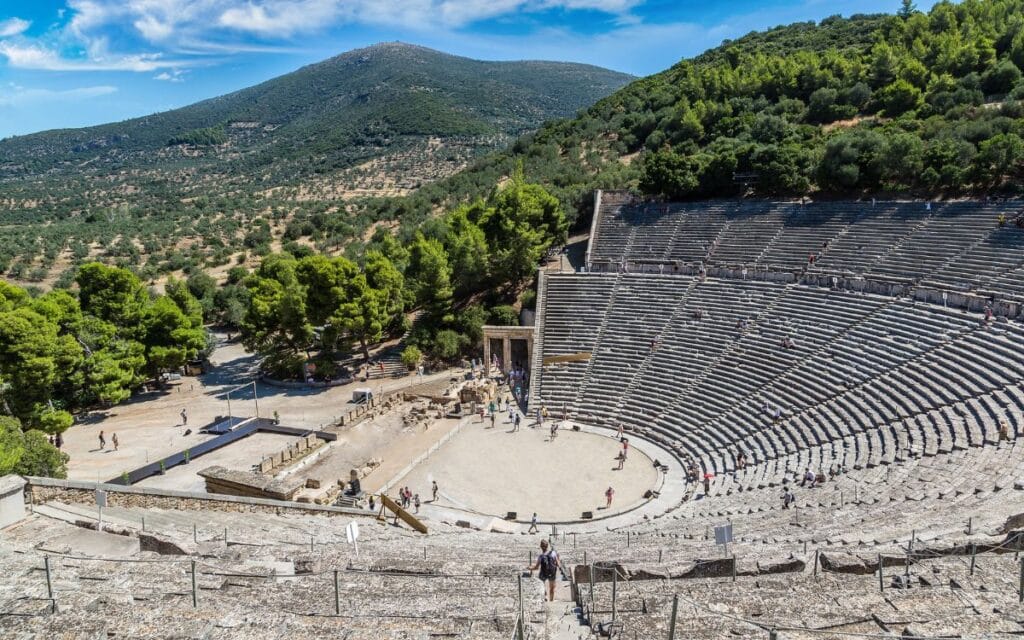Ancient Theater of Epidaurus
Ancient Theater of Epidaurus

The theater was constructed in honor of Asclepius, the Greek god of healing, as Epidaurus was known as a major sanctuary dedicated to him. It is believed that the theater played a central role in the religious and cultural life of the city, hosting musical and dramatic performances, particularly during the Asklepieia, a festival honoring Asclepius. The site also served as a venue for healing rituals, where the people of ancient Greece would come to seek cures through both physical treatments and spiritual practices.
Designed by the architect Polykleitos the Younger, the Theater of Epidaurus was built to accommodate up to 14,000 spectators. The theater is carved into the natural hillside, creating a visually stunning amphitheater that blends seamlessly with the surrounding landscape. Its design, based on precise geometrical principles, allowed for perfect acoustics, ensuring that even the slightest sound could be heard clearly by every person in the audience, no matter where they were seated. This extraordinary feature has fascinated architects and engineers for centuries and continues to be one of the theater’s most remarkable aspects.
The theater consists of two main parts: the orchestra and the cavea. The orchestra, the circular area at the center of the theater, was where the actors and chorus performed during ancient Greek plays. The cavea, or seating area, is divided into sections with rows of stone seats that rise in a semi-circular shape, providing an unobstructed view of the stage. The overall structure is a testament to the skill and ingenuity of ancient Greek architects, combining both functionality and beauty in a way that still resonates with modern audiences.
In addition to its architectural brilliance, the Ancient Theater of Epidaurus is famous for hosting performances of ancient Greek tragedies and comedies. It is still used today for cultural events, most notably the Epidaurus Festival, which takes place each summer and features performances of classic Greek plays, such as those written by Aeschylus, Sophocles, and Euripides. The Epidaurus Festival draws theater lovers and tourists from across the globe, who come to experience the magic of ancient drama in the very place where it all began.
The theater’s natural setting adds to its charm and appeal. Surrounded by lush green hills and situated in the heart of the archaeological site of Epidaurus, the theater offers visitors a tranquil and breathtaking environment. The area is part of the larger archaeological site of Epidaurus, which includes the Sanctuary of Asclepius, ancient baths, and numerous other well-preserved ruins. This makes the Theater of Epidaurus not only a place to experience the beauty of ancient architecture but also a site rich in history and spiritual significance.
For visitors, the theater is more than just a historical monument – it is a living, breathing part of Greece’s cultural heritage. Its timeless design and continued use for theatrical performances offer a unique opportunity to experience the classical Greek tradition in an authentic setting. Whether you are a lover of history, architecture, or theater, the Ancient Theater of Epidaurus is a site that should be on every traveler’s list when exploring Greece.
In summary, the Ancient Theater of Epidaurus is a true gem of ancient Greek architecture and culture. Its incredible acoustics, impressive design, and rich history make it a must-see destination for anyone visiting Greece. Whether you are attending a performance, exploring the ruins, or simply taking in the natural beauty of the surroundings, a visit to the Theater of Epidaurus is a memorable and immersive experience that will leave you with a deep appreciation for the artistic and architectural achievements of ancient Greece.

